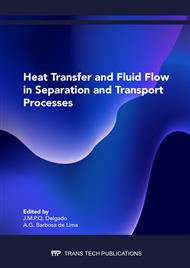[1]
T.C.D. Gonçalves, Salt crystallization in plastered or rendered walls,, Technical University of Lisbon, (2007).
Google Scholar
[2]
T.L. Brown, Chemistry: the central science: Pearson Education, (2009).
Google Scholar
[3]
T.S.M.R. Rego, (2014). Efeito de soluções aquosas salinas nos processos de embebição de paredes com múltiplas camadas, MSc Thesis, Faculdade de Engenharia da universidade do Porto, Portugal.
DOI: 10.24873/j.rpemd.2022.10.879
Google Scholar
[4]
C. Strege, (2004). On (pseudo-) polymorphic phase transformations. Martin-Luther-Universitat Halle-Wittenberg, Germany.
Google Scholar
[5]
L. A. Rijniers, Salt crystallization in porous materials: an NMR study: Technische Universiteit Eindhoven, (2004).
Google Scholar
[6]
A. E. Charola, (2000). Salts in the deterioration of porous materials: an overview. Journal of the American institute for conservation. vol. 39, pp.327-343.
DOI: 10.1179/019713600806113176
Google Scholar
[7]
P. Puim, Controlo e reparação de anomalias devidas à presença de sais solúveis em edifícios antigos,, MSc Thesis, IST, Lisboa, (2010).
Google Scholar
[8]
V. P. de Freitas, Humidade Ascencional vol. 3: FEUP edições, Porto, Portugal, (2008).
Google Scholar
[9]
M. Janz, (1997). Methods of measuring the moisture diffusivity at high moisture levels. Report TVBM 3076.
Google Scholar
[10]
T.D. Gonçalves and J. D. Rodrigues, (2006). Evaluating the salt content of salt-contaminated samples on the basis of their hygroscopic behaviour. Part I: Fundamentals, scope and accuracy of the method. Journal of Cultural Heritage. vol. 7, pp.79-84.
DOI: 10.1016/j.culher.2006.02.009
Google Scholar
[11]
J.M.C.B. Azevedo, (2013). Absorção por Capilaridade de Soluções Aquosas Salinas em Materiais Porosos. MSc Thesis, Faculdade de Engenharia da universidade do Porto, Portugal.
DOI: 10.24873/j.rpemd.2022.09.876
Google Scholar
[12]
M.A. Wilson et al., (1995). Water movement in porous building materials - XIII. Absorption into a two-layer composite. Building and Environment, vol. 30, pp.209-219.
DOI: 10.1016/0360-1323(94)00035-q
Google Scholar
[13]
M.A. Wilson et al., (1995). Water movement in porous building materials - XIV. Absorption into a two-layer composite (SA< SB). Building and environment, vol. 30, pp.221-227.
DOI: 10.1016/0360-1323(94)00036-r
Google Scholar
[14]
Lubelli B, Van Hees RPJ, Brocken HJP (2004) Experimental research on hygroscopic behaviour of porous specimens contaminated with salts. Constr Build Mater18(5):339-348.
DOI: 10.1016/j.conbuildmat.2004.02.007
Google Scholar
[15]
E. Ruiz-Agudo et al., (2007). The role of saline solution properties on porous limestone salt weathering by magnesium and sodium sulfates. Environmental geology, vol. 52, pp.269-281.
DOI: 10.1007/s00254-006-0476-x
Google Scholar
[16]
V.A.G. Ribeiro, F.A.N. Silva, A.C. Azevedo and J.M.P.Q. Delgado (2020), The Effect of Soluble Mineral Salts in Ceramic Brick Masonry,, International Journal of Civil Engineering, v. 18 (6), 685–699.
DOI: 10.1007/s40999-020-00502-x
Google Scholar
[17]
Doehne E, Price C (2010) Stone conservation: an overview of current research. Second edition, The Getty Conservation Institute, Los Angeles, USA.
Google Scholar
[18]
Lindqvist J (2009) Rilem TC 203-RHM: Repair mortars for historic masonry. Testing of hardened mortars, a process of questioning and interpreting. Mater Struct 42: 853-865.
DOI: 10.1617/s11527-008-9455-x
Google Scholar
[19]
Gummerson RJ, Hall C, Hoff W (1980) Water movement in porous building materials-II. Hydraulic suction and sorptivity of brick and other masonry materials. Build Environm 15(2):101-108.
DOI: 10.1016/0360-1323(80)90015-3
Google Scholar
[20]
Zappia G, Sabbioni C, Riontino C, Gobbi G, Favoni O (1998) Exposure tests of building materials in urban atmosphere. Sci Total Environ 224:235-244.
DOI: 10.1016/s0048-9697(98)00359-3
Google Scholar
[21]
N. Shahidzadeh-Bonn et al., (2010). Damage in porous media due to salt crystallization. Physical Review E, vol. 81, p.066110.
DOI: 10.1103/physreve.81.066110
Google Scholar
[22]
RILEM, (1980). 25-PEM, Recommended tests to measure the deterioration of stone and to assess the efectiveness of treatment methods. Test nº II. 5–Evaporation curve. Materials & Structures. vol. 13, pp.205-207.
Google Scholar
[23]
C. Rodriguez-Navarro et al., (2000). How does sodium sulphate crystallize? Implications for the decay and testing of building materials. Cement and concrete research. vol. 30, pp.1527-1534.
DOI: 10.1016/s0008-8846(00)00381-1
Google Scholar
[24]
C. Normal, (1991). Misura dell'indice di asciugamento (drying index). Roma, CNR/ICR, Doc. vol. 29, p.88.
Google Scholar
[25]
V.P.S. Brito, Influência dos revestimentos por pintura na secagem do suporte,, National Laboratory of Civil Engineering, (2009).
Google Scholar


